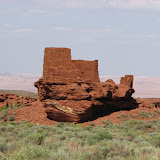Location: Wupatki National Monument and Sunset Crater National Monument
Time and temperature: All day, upper 60's to lower 90's.
Distance hiked: Three or 4 miles
The numbers:
154 Pictures taken
10 Hours spent in truck
Ramblings: About 3 years ago, I had gone to Sunset Crater and Wupatki National Monument. I saw several collared lizards then and I wanted to get some better pictures of them. I've been thinking about this all summer. I finally made it up there yesterday. It's a longer drive than I remembered, almost 4 hours one way (I drive slow). I didn't get home until some time after 2130 and I had to skip dinner to get home that early. I was worn out, and my feet were killing me from all the up and down hill hiking. The sad thing is, I didn't see a single collared lizard. The trip was still worth it, though. I saw stuff I hadn't seen last time. Also, since this is Arizona, the scenery is beautiful wherever you go.
The cinders in Sunset Crater National Monument don't hold water; rain just drains right through them. The area receives only about 16 inches of rain a year. Consequently, much of the landscape look desolate. There are forests of Ponderosa pine, but there are also large areas where almost nothing can grow.
One of the most interesting things about Wupatki (to me, anyway) is the blow hole. Under the right conditions (dropping barometric pressure), cool air continuously blows out of the hole. Based on the flow rate, barometric pressure, etc., etc., the volume of the caverns to which the blow hole is connected is estimated to be about 7 billion cubic feet. That's a pretty substantial volume. Imagine a cube almost 2000 feet on each side. Of course, it's probably not one big room and may just consist of a lot of narrow channels. Nobody knows, though. It is sacred to Native Americans, so there has been almost no exploration of the cavern beneath the blow hole. Nobody has been inside of it. BTW, if you ever go see the blow hole, the sign next to it is misleading. It says something about warm, less dense air rising from the blow hole and cold dense air falling it. That's silly. A change in barometric pressure is the only thing that will cause air to flow in or out. I suppose that if warm air is flowing in, it could be cooled by contact with with cavern walls, which would reduce it's volume and increase the flow rate. The main driving force is barometric pressure, though.
 |
| Wupatki_20 |
I found a video on YouTube that shows how forcefully the air can come out of the blow hole. Ignore the blabbermouth and watch how the girl's hair gets blown around.




1 comment:
Sure are nice pics. I'm ready to take the family up there again now.
Post a Comment